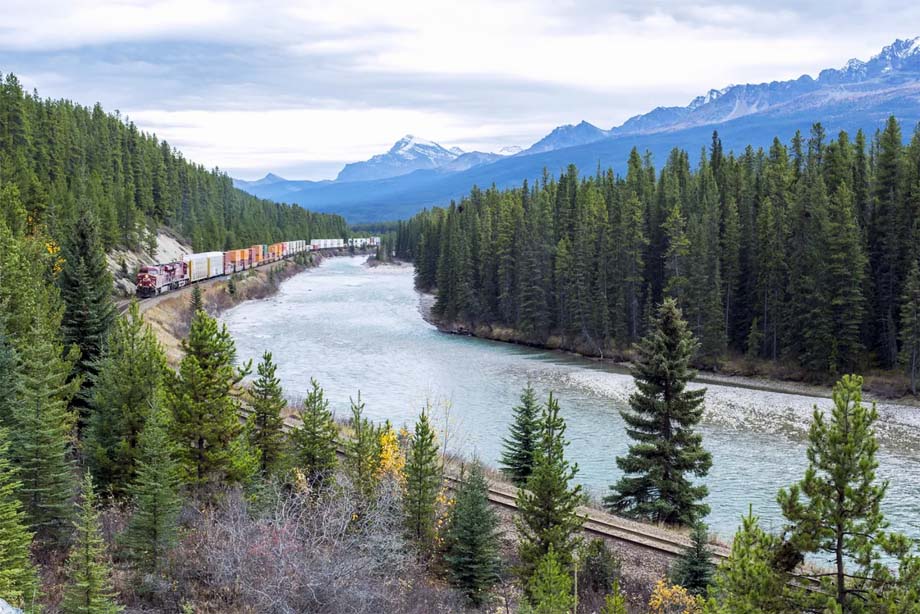
Edmonton Alberta - Alberta has punted an ambitious plan to build a passenger rail link between
Calgary and Banff back to the private proponents of the project, saying that as it stands, the financial risks for the
province are too high.
The current plan underestimates the capital costs of the project, currently pegged at about $1.5 billion, and what will
be required from the province in terms of an annual financial contribution, according to Alberta Transportation
Minister Prasad Panda.
It overestimates the potential ridership, he said, adding a construction schedule that envisions the service running in
the mid-2020s is unrealistic.
"At this moment, as it's presented, it's passing on all the risk to Alberta taxpayers," Mr. Panda said in an
interview Wednesday.
In the past, the idea of the Calgary-Banff rail project has generated excitement from provincial officials, including
Invest Alberta, the entity created to promote tourism, tech, energy, agriculture, and other sectors.
The Transportation Minister said he likes the idea of the project, which could reduce the number of people driving to
ever-more-crowded Banff National Park.
It could help diversify the province's economy by boosting the tourism sector.
And proponents say it would lower greenhouse-gas transportation emissions by reducing the vehicles going to the park,
and could be North America's first hydrogen-powered passenger train system.
"Those things are good. But it shouldn't be pie-in-the-sky," Mr. Panda said.
The project's private booster, Alberta-based Liricon Capital Ltd., along with co-developer Plenary Americas, owned by
the giant Caisse de depot et placement du Quebec, have argued it is "uniquely low-risk to
taxpayers."
They have said construction costs will be lower and timelines shorter than many big projects because of the existing
railway corridor.
In the past three years, the idea of the rail project has been a rare point of agreement for the provincial and federal
governments.
But the financial implications for the province have come under recent scrutiny from Alberta's transportation
department and cabinet, including Premier Jason Kenney, who will leave provincial politics in October.
"We want a realistic proposal, a feasible proposal," Mr. Panda said, adding his office has sent a letter to
the proponents this week outlining its position.
"If they can assume those risks, and if they can raise private capital, without penalizing Alberta taxpayers,
we'll reconsider it."
Mr. Panda added there's still an outstanding question of what the federal contribution to the project will
be.
So far, it's only the Canada Infrastructure Bank that has said it's prepared to provide a loan for half the $1.5
billion capital cost.
The proposed rail service would mean building a dedicated passenger rail line as a twin to the existing Canadian
Pacific Railway track to avoid impeding the near-constant shipping of freight.
The line would begin at the Calgary airport and make stops downtown, and in Cochrane, the Morley reserve of the Stoney
Nakoda Nations, and Canmore.
Liricon and Plenary submitted a proposal on the Calgary-Banff rail project to the Alberta government and the Canada
Infrastructure Bank in November.
Under that plan, part of the capital costs and interest would be paid back, once the service is actually up and
running, by the province.
It would pay $30 million annually for 50 years.
Alberta would eventually own the project, but a yet-to-be-named private entity would build and operate the
service.
As envisioned by Liricon and Plenary, half of the $1.5 billion in capital required for the project will be provided by
the Infrastructure Bank, with remaining 50 percent being provided through a combination of debt from private lenders,
and from Liricon and Plenary themselves.
Last month, Liricon managing partner Jan Waterous put out a news release that said a new ridership study that shows the
$30 million in annual payments from the province might not be necessary if the park encourages mass transit-use with
strategies such as raising the park entry fee for private passenger vehicles, or expanding bus and shuttle service
between park attractions.
Ms. Waterous, who with husband Adam owns the Mount Norquay ski resort located in the park as well as the long-term
lease on the Banff train station, said the study they commissioned found the train could carry up to 11 million
passengers a year by 2035, five times more than originally projected in Liricon's first proposal.
The train system could be integrated with regional transit systems, and be a part of tourist packages with the
country's major airlines, she added.
In a message on Wednesday, Ms. Waterous said the letter from the province this week is part of the back-and-forth on
the project.
"Not surprisingly, the Alberta government wants to reduce the cost to the taxpayer, and our ridership study shows
that this is possible," she said, adding she doesn't believe the province has responded to all of the proponents'
updated plans.
"This is just part of the process of a complex project where ongoing dialogue with the government is
paramount."
However, Mr. Panda said the proponents want Alberta government to backstop early project development costs, and assume
financial risks for the project that will be outside of the province's control.
He said the province's annual costs, based on his department's analysis, would be "much more" than $30
million, as would the upfront capital cost estimate of $1.5 billion.
Consultations and regulatory approvals are likely to take much longer than forecast.
And Mr. Panda also highlighted that the proponents have yet to reach formal agreement with CP.
For instance, space is constrained in downtown Calgary, and new land will be needed to accommodate a second set of
tracks.
Kelly Cryderman.
(likely no image with original article)
(usually because it's been seen before)
provisions in Section 29 of the
Canadian Copyright Modernization Act.
